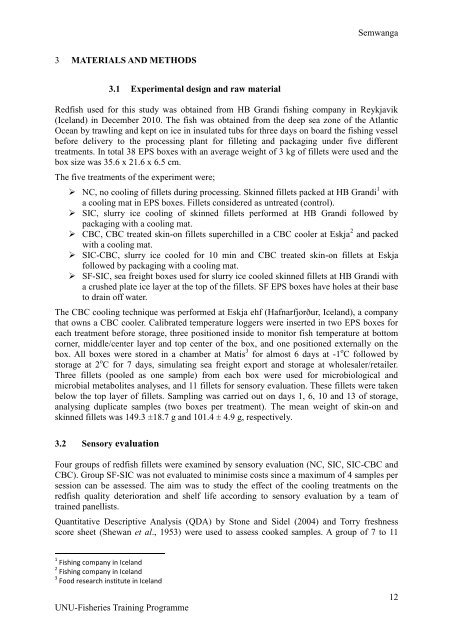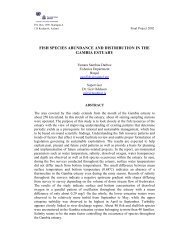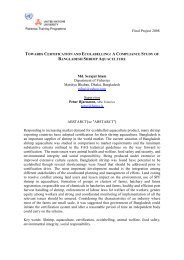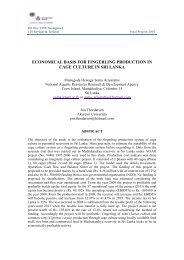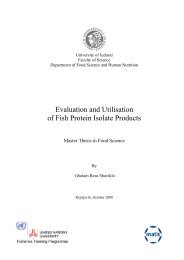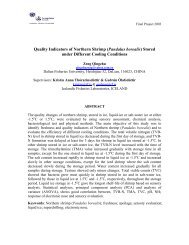THE EFFECT OF DIFFERENT COOLING TECHNIQUES ON THE ...
THE EFFECT OF DIFFERENT COOLING TECHNIQUES ON THE ...
THE EFFECT OF DIFFERENT COOLING TECHNIQUES ON THE ...
Create successful ePaper yourself
Turn your PDF publications into a flip-book with our unique Google optimized e-Paper software.
Semwanga3MATERIALS AND METHODS3.1 Experimental design and raw materialRedfish used for this study was obtained from HB Grandi fishing company in Reykjavik(Iceland) in December 2010. The fish was obtained from the deep sea zone of the AtlanticOcean by trawling and kept on ice in insulated tubs for three days on board the fishing vesselbefore delivery to the processing plant for filleting and packaging under five differenttreatments. In total 38 EPS boxes with an average weight of 3 kg of fillets were used and thebox size was 35.6 x 21.6 x 6.5 cm.The five treatments of the experiment were;‣ NC, no cooling of fillets during processing. Skinned fillets packed at HB Grandi 1 witha cooling mat in EPS boxes. Fillets considered as untreated (control).‣ SIC, slurry ice cooling of skinned fillets performed at HB Grandi followed bypackaging with a cooling mat.‣ CBC, CBC treated skin-on fillets superchilled in a CBC cooler at Eskja 2 and packedwith a cooling mat.‣ SIC-CBC, slurry ice cooled for 10 min and CBC treated skin-on fillets at Eskjafollowed by packaging with a cooling mat.‣ SF-SIC, sea freight boxes used for slurry ice cooled skinned fillets at HB Grandi witha crushed plate ice layer at the top of the fillets. SF EPS boxes have holes at their baseto drain off water.The CBC cooling technique was performed at Eskja ehf (Hafnarfjorður, Iceland), a companythat owns a CBC cooler. Calibrated temperature loggers were inserted in two EPS boxes foreach treatment before storage, three positioned inside to monitor fish temperature at bottomcorner, middle/center layer and top center of the box, and one positioned externally on thebox. All boxes were stored in a chamber at Matis 3 for almost 6 days at -1 o C followed bystorage at 2 o C for 7 days, simulating sea freight export and storage at wholesaler/retailer.Three fillets (pooled as one sample) from each box were used for microbiological andmicrobial metabolites analyses, and 11 fillets for sensory evaluation. These fillets were takenbelow the top layer of fillets. Sampling was carried out on days 1, 6, 10 and 13 of storage,analysing duplicate samples (two boxes per treatment). The mean weight of skin-on andskinned fillets was 149.3 ±18.7 g and 101.4 ± 4.9 g, respectively.3.2 Sensory evaluationFour groups of redfish fillets were examined by sensory evaluation (NC, SIC, SIC-CBC andCBC). Group SF-SIC was not evaluated to minimise costs since a maximum of 4 samples persession can be assessed. The aim was to study the effect of the cooling treatments on theredfish quality deterioration and shelf life according to sensory evaluation by a team oftrained panellists.Quantitative Descriptive Analysis (QDA) by Stone and Sidel (2004) and Torry freshnessscore sheet (Shewan et al., 1953) were used to assess cooked samples. A group of 7 to 111 Fishing company in Iceland2 Fishing company in Iceland3 Food research institute in IcelandUNU-Fisheries Training Programme12


